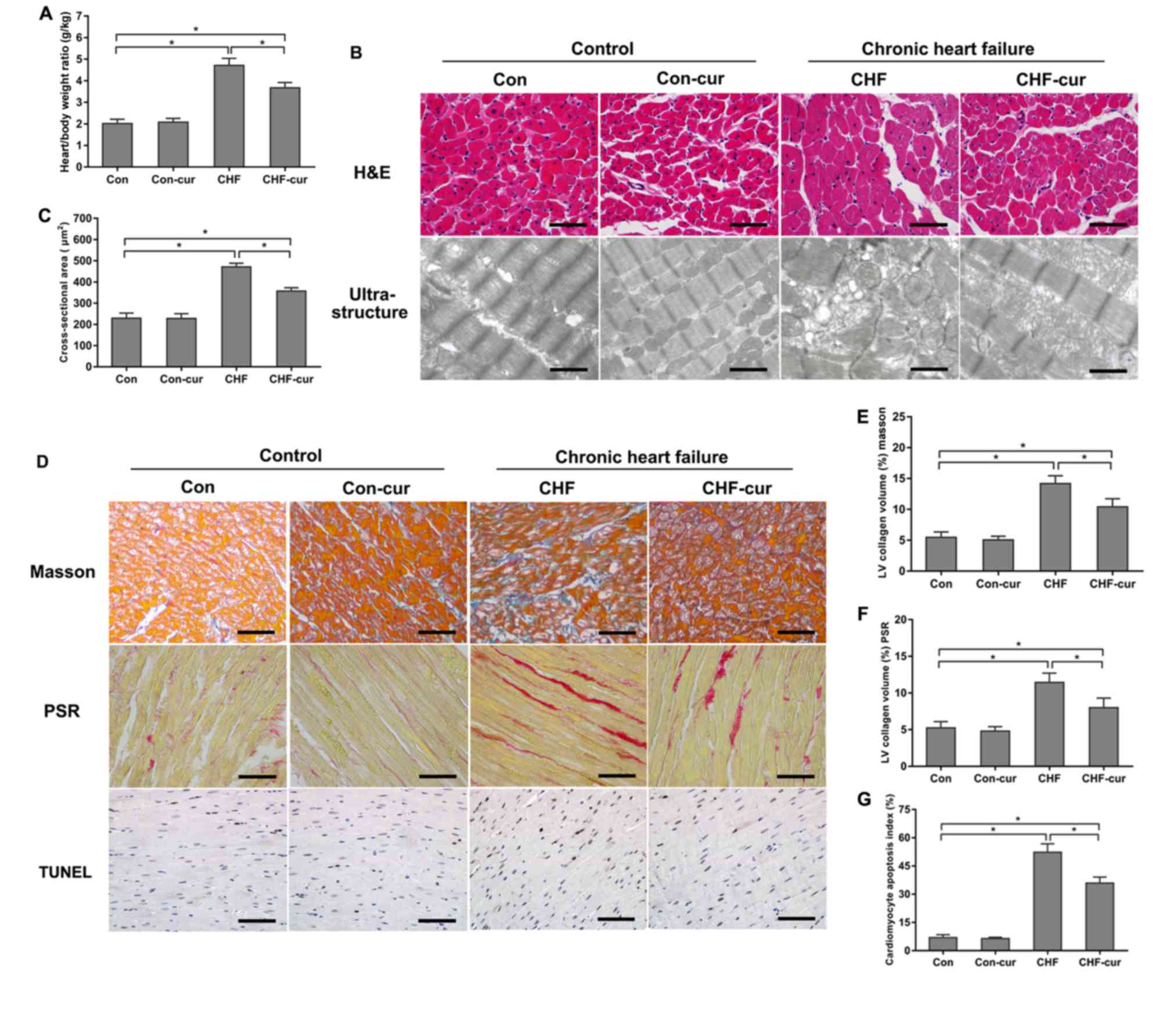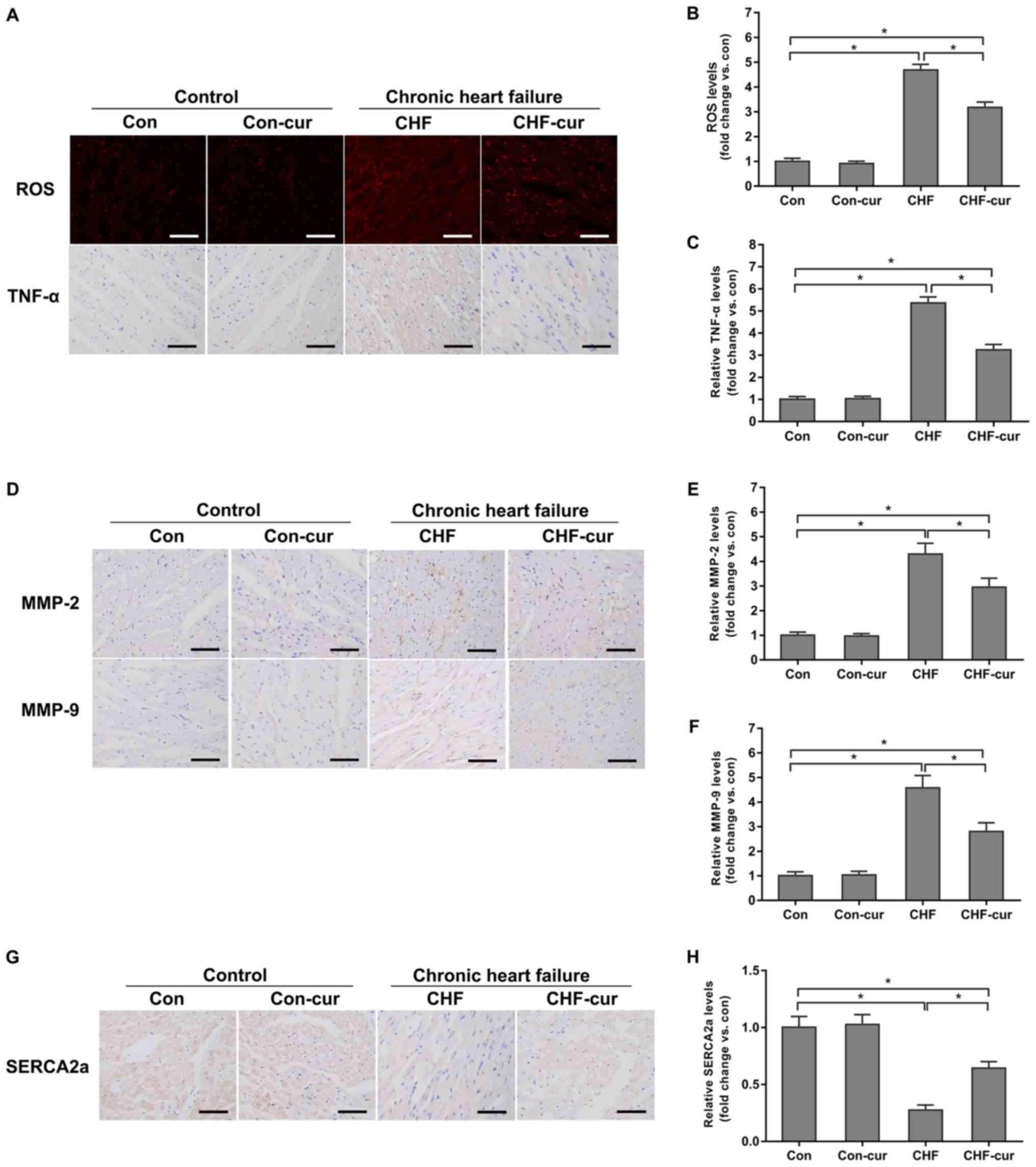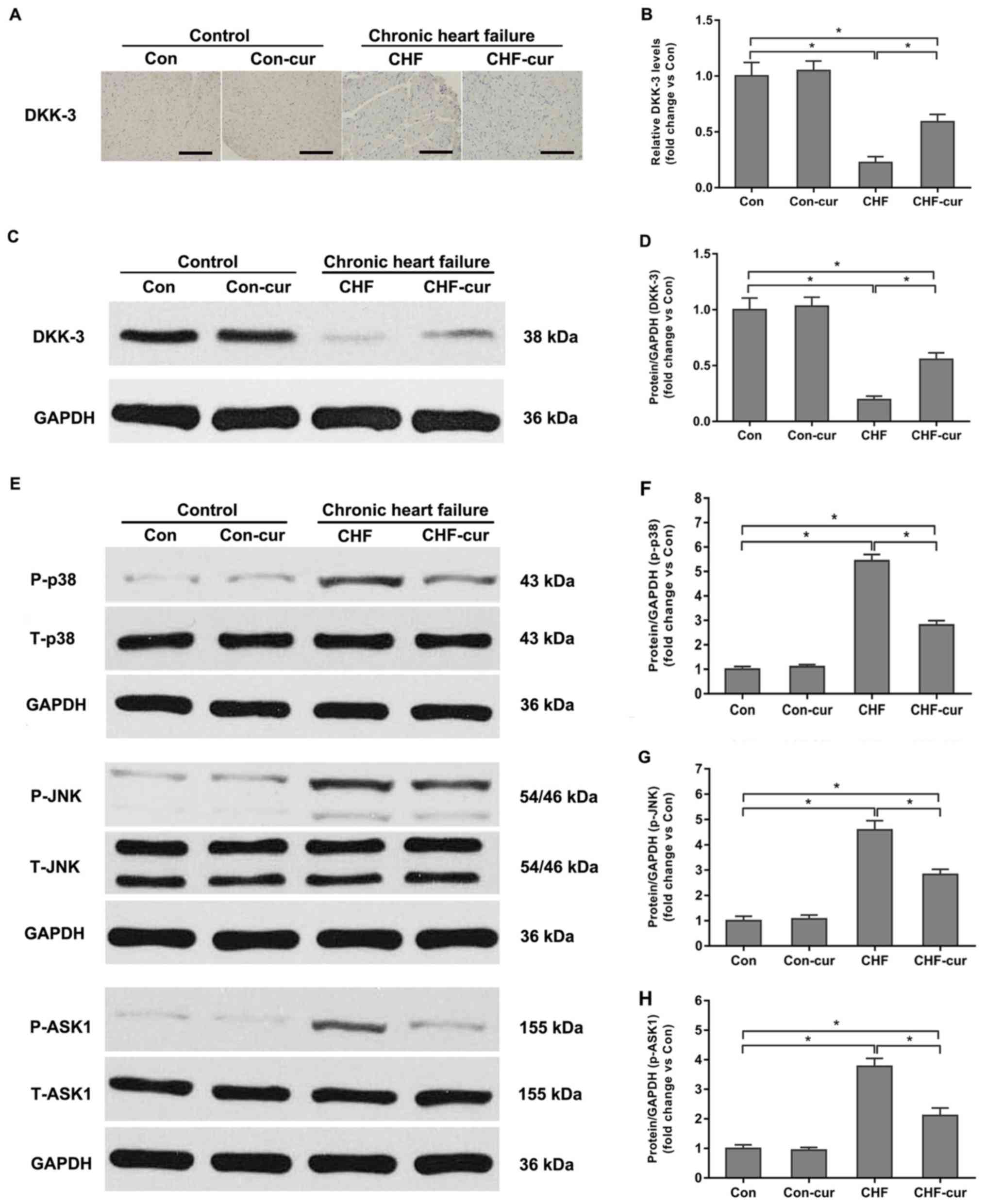|
1
|
Cook C, Cole G, Asaria P, Jabbour R and
Francis DP: The annual global economic burden of heart failure. Int
J Cardiol. 171:368–376. 2014. View Article : Google Scholar : PubMed/NCBI
|
|
2
|
Benjamin EJ, Blaha MJ, Chiuve SE, Cushman
M, Das SR, Deo R, de Ferranti SD, Floyd J, Fornage M, Gillespie C,
et al: Heart disease and stroke statistics-2017 update: A report
from the american heart association. Circulation. 135:e146–e603.
2017. View Article : Google Scholar : PubMed/NCBI
|
|
3
|
Josiak K, Jankowska EA, Piepoli MF,
Banasiak W and Ponikowski P: Skeletal myopathy in patients with
chronic heart failure: Significance of anabolic-androgenic
hormones. J Cachexia Sarcopenia Muscle. 5:287–296. 2014. View Article : Google Scholar : PubMed/NCBI
|
|
4
|
Koitabashi N and Kass DA: Reverse
remodeling in heart failure-mechanisms and therapeutic
opportunities. Nat Rev Cardiol. 9:147–157. 2012. View Article : Google Scholar
|
|
5
|
Zhang Y, Liu Y, Zhu XH, Zhang XD, Jiang
DS, Bian ZY, Zhang XF, Chen K, Wei X, Gao L, et al: Dickkopf-3
attenuates pressure overload-induced cardiac remodelling.
Cardiovasc Res. 102:35–45. 2014. View Article : Google Scholar : PubMed/NCBI
|
|
6
|
Hofmann U and Frantz S: How can we cure a
heart ‘in flame’? A translational view on inflammation in heart
failure. Basic Res Cardiol. 108:3562013. View Article : Google Scholar : PubMed/NCBI
|
|
7
|
Rahman AF, Angawi RF and Kadi AA: Spatial
localisation of curcumin and rapid screening of the chemical
compositions of turmeric rhizomes (Curcuma longa Linn.) using
direct analysis in real time-mass spectrometry (DART-MS). Food
Chem. 173:489–494. 2015. View Article : Google Scholar : PubMed/NCBI
|
|
8
|
Jankun J, Wyganowska-Swiatkowska M,
Dettlaff K, Jelinska A, Surdacka A, Watrobska-Swietlikowska D and
Skrzypczak-Jankun E: Determining whether curcumin
degradation/condensation is actually bioactivation (Review). Int J
Mol Med. 37:1151–1158. 2016. View Article : Google Scholar : PubMed/NCBI
|
|
9
|
Parada E, Buendia I, Navarro E, Avendano
C, Egea J and Lopez MG: Microglial HO-1 induction by curcumin
provides antioxidant, antineuroinflammatory, and glioprotective
effects. Mol Nutr Food Res. 59:1690–1700. 2015. View Article : Google Scholar : PubMed/NCBI
|
|
10
|
Zhu X, Li Q, Chang R, Yang D, Song Z, Guo
Q and Huang C: Curcumin alleviates neuropathic pain by inhibiting
p300/CBP histone acetyltransferase activity-regulated expression of
BDNF and cox-2 in a rat model. PloS One. 9:e913032014. View Article : Google Scholar : PubMed/NCBI
|
|
11
|
Lee JY, Lee YM, Chang GC, Yu SL, Hsieh WY,
Chen JJ, Chen HW and Yang PC: Curcumin induces EGFR degradation in
lung adenocarcinoma and modulates p38 activation in intestine: The
versatile adjuvant for gefitinib therapy. PloS One. 6:e237562011.
View Article : Google Scholar : PubMed/NCBI
|
|
12
|
Morimoto T, Sunagawa Y, Kawamura T, Takaya
T, Wada H, Nagasawa A, Komeda M, Fujita M, Shimatsu A, Kita T and
Hasegawa K: The dietary compound curcumin inhibits p300 histone
acetyltransferase activity and prevents heart failure in rats. J
Clin Invest. 118:868–878. 2008.PubMed/NCBI
|
|
13
|
Li HY, Yang M, Li Z and Meng Z: Curcumin
inhibits angiotensin II-induced inflammation and proliferation of
rat vascular smooth muscle cells by elevating PPAR-gamma activity
and reducing oxidative stress. Int J Mol Med. 39:1307–1316. 2017.
View Article : Google Scholar : PubMed/NCBI
|
|
14
|
Ochiai K, Watanabe M, Ueki H, Huang P,
Fujii Y, Nasu Y, Noguchi H, Hirata T, Sakaguchi M, Huh NH, et al:
Tumor suppressor REIC/Dkk-3 interacts with the dynein light chain,
Tctex-1. Biochem Biophys Res Commun. 412:391–395. 2011. View Article : Google Scholar : PubMed/NCBI
|
|
15
|
Veeck J and Dahl E: Targeting the Wnt
pathway in cancer: The emerging role of Dickkopf-3. Biochim Biophys
Acta. 1825:18–28. 2012.PubMed/NCBI
|
|
16
|
Bao MW, Cai Z, Zhang XJ, Li L, Liu X, Wan
N, Hu G, Wan F, Zhang R, Zhu X, et al: Dickkopf-3 protects against
cardiac dysfunction and ventricular remodelling following
myocardial infarction. Basic Res Cardiol. 110:252015. View Article : Google Scholar : PubMed/NCBI
|
|
17
|
Yao QH, Wang DQ, Cui CC, Yuan ZY, Chen SB,
Yao XW, Wang JK and Lian JF: Curcumin ameliorates left ventricular
function in rabbits with pressure overload: Inhibition of the
remodeling of the left ventricular collagen network associated with
suppression of myocardial tumor necrosis factor-alpha and matrix
metalloproteinase-2 expression. Biol Pharm Bull. 27:198–202. 2004.
View Article : Google Scholar : PubMed/NCBI
|
|
18
|
Nikolaidou T, Cai XJ, Stephenson RS, Yanni
J, Lowe T, Atkinson AJ, Jones CB, Sardar R, Corno AF, Dobrzynski H,
et al: Congestive heart failure leads to prolongation of the PR
interval and atrioventricular junction enlargement and ion channel
remodelling in the rabbit. PloS One. 10:e01414522015. View Article : Google Scholar : PubMed/NCBI
|
|
19
|
Mukherjee R, Mingoia JT, Bruce JA, Austin
JS, Stroud RE, Escobar GP, McClister DM Jr, Allen CM, Alfonso-Jaume
MA, Fini ME, et al: Selective spatiotemporal induction of matrix
metalloproteinase-2 and matrix metalloproteinase-9 transcription
after myocardial infarction. Am J Physiol Heart Circ Physiol.
291:H2216–H2228. 2006. View Article : Google Scholar : PubMed/NCBI
|
|
20
|
Dhalla NS, Saini-Chohan HK,
Rodriguez-Leyva D, Elimban V, Dent MR and Tappia PS: Subcellular
remodelling may induce cardiac dysfunction in congestive heart
failure. Cardiovasc Res. 81:429–438. 2009. View Article : Google Scholar : PubMed/NCBI
|
|
21
|
Zhang F, Dang Y, Li Y, Hao Q, Li R and Qi
X: Cardiac Contractility modulation attenuate myocardial fibrosis
by inhibiting TGF-β1/Smad3 signaling pathway in a rabbit model of
chronic heart failure. Cell Physiol Biochem. 39:294–302. 2016.
View Article : Google Scholar : PubMed/NCBI
|
|
22
|
Soetikno V, Sari FR, Lakshmanan AP,
Arumugam S, Harima M, Suzuki K, Kawachi H and Watanabe K: Curcumin
alleviates oxidative stress, inflammation, and renal fibrosis in
remnant kidney through the Nrf2-keap1 pathway. Mol Nutr Food Res.
57:1649–1659. 2013. View Article : Google Scholar : PubMed/NCBI
|
|
23
|
Hori M and Nishida K: Oxidative stress and
left ventricular remodelling after myocardial infarction.
Cardiovasc Res. 81:457–464. 2009. View Article : Google Scholar : PubMed/NCBI
|
|
24
|
Munzel T, Gori T, Keaney JF Jr, Maack C
and Daiber A: Pathophysiological role of oxidative stress in
systolic and diastolic heart failure and its therapeutic
implications. Eur Heart J. 36:2555–2564. 2015. View Article : Google Scholar : PubMed/NCBI
|
|
25
|
Deo SH, Fisher JP, Vianna LC, Kim A,
Chockalingam A, Zimmerman MC, Zucker IH and Fadel PJ: Statin
therapy lowers muscle sympathetic nerve activity and oxidative
stress in patients with heart failure. Am J Physiol Heart Circ
Physiol. 303:H377–H385. 2012. View Article : Google Scholar : PubMed/NCBI
|
|
26
|
Qui S, Kano J and Noguchi M: Dickkopf 3
attenuates xanthine dehydrogenase expression to prevent oxidative
stress-induced apoptosis. Genes Cells. 22:406–417. 2017. View Article : Google Scholar : PubMed/NCBI
|
|
27
|
Zhou X, Zhang J, Xu C and Wang W: Curcumin
ameliorates renal fibrosis by inhibiting local fibroblast
proliferation and extracellular matrix deposition. J Pharmacol Sci.
126:344–350. 2014. View Article : Google Scholar : PubMed/NCBI
|
|
28
|
Zhang F, Zhang Z, Chen L, Kong D, Zhang X,
Lu C, Lu Y and Zheng S: Curcumin attenuates angiogenesis in liver
fibrosis and inhibits angiogenic properties of hepatic stellate
cells. J Cell Mol Med. 18:1392–1406. 2014. View Article : Google Scholar : PubMed/NCBI
|
|
29
|
Wang ME, Chen YC, Chen IS, Hsieh SC, Chen
SS and Chiu CH: Curcumin protects against thioacetamide-induced
hepatic fibrosis by attenuating the inflammatory response and
inducing apoptosis of damaged hepatocytes. J Nutr Biochem.
23:1352–1366. 2012. View Article : Google Scholar : PubMed/NCBI
|
|
30
|
Bonnans C, Chou J and Werb Z: Remodelling
the extracellular matrix in development and disease. Nat Rev Mol
Cell Biol. 15:786–801. 2014. View
Article : Google Scholar : PubMed/NCBI
|
|
31
|
Vanhoutte D, van Almen GC, Van Aelst LN,
Van Cleemput J, Droogne W, Jin Y, Van de Werf F, Carmeliet P,
Vanhaecke J, Papageorgiou AP and Heymans S: Matricellular proteins
and matrix metalloproteinases mark the inflammatory and fibrotic
response in human cardiac allograft rejection. Eur Heart J.
34:1930–1941. 2013. View Article : Google Scholar : PubMed/NCBI
|
|
32
|
Takawale A, Sakamuri SS and Kassiri Z:
Extracellular matrix communication and turnover in cardiac
physiology and pathology. Compr Physiol. 5:687–719. 2015.
View Article : Google Scholar : PubMed/NCBI
|
|
33
|
Dodd T, Jadhav R, Wiggins L, Stewart J,
Smith E, Russell JC and Rocic P: MMPs 2 and 9 are essential for
coronary collateral growth and are prominently regulated by p38
MAPK. J Mol Cell Cardiol. 51:1015–1025. 2011. View Article : Google Scholar : PubMed/NCBI
|
|
34
|
Liang KC, Lee CW, Lin WN, Lin CC, Wu CB,
Luo SF and Yang CM: Interleukin-1beta induces MMP-9 expression via
p42/p44 MAPK, p38 MAPK, JNK, and nuclear factor-kappaB signaling
pathways in human tracheal smooth muscle cells. J Cell Physiol.
211:759–770. 2007. View Article : Google Scholar : PubMed/NCBI
|
|
35
|
Cuenda A and Rousseau S: p38 MAP-kinases
pathway regulation, function and role in human diseases. Biochim
Biophys Acta. 1773:1358–1375. 2007. View Article : Google Scholar : PubMed/NCBI
|
|
36
|
Romero D, Al-Shareef Z, Gorrono-Etxebarria
I, Atkins S, Turrell F, Chhetri J, Bengoa-Vergniory N, Zenzmaier C,
Berger P, Waxman J and Kypta R: Dickkopf-3 regulates prostate
epithelial cell acinar morphogenesis and prostate cancer cell
invasion by limiting TGF-β-dependent activation of matrix
metalloproteases. Carcinogenesis. 37:18–29. 2016. View Article : Google Scholar : PubMed/NCBI
|
|
37
|
Brini M and Carafoli E: Calcium pumps in
health and disease. Physiol Rev. 89:1341–1378. 2009. View Article : Google Scholar : PubMed/NCBI
|
|
38
|
Roe AT, Frisk M and Louch WE: Targeting
cardiomyocyte Ca2+ homeostasis in heart failure. Curr Pharm Des.
21:431–448. 2015. View Article : Google Scholar : PubMed/NCBI
|
|
39
|
Inesi G, Prasad AM and Pilankatta R: The
Ca2+ ATPase of cardiac sarcoplasmic reticulum: Physiological role
and relevance to diseases. Biochem Biophys Res Commun. 369:182–187.
2008. View Article : Google Scholar : PubMed/NCBI
|
|
40
|
Cutler MJ, Wan X, Plummer BN, Liu H,
Deschenes I, Laurita KR, Hajjar RJ and Rosenbaum DS: Targeted
sarcoplasmic reticulum Ca2+ ATPase 2a gene delivery to restore
electrical stability in the failing heart. Circulation.
126:2095–2104. 2012. View Article : Google Scholar : PubMed/NCBI
|
|
41
|
Huang CL: SERCA2a stimulation by
istaroxime: A novel mechanism of action with translational
implications. Br J Pharmacol. 170:486–488. 2013. View Article : Google Scholar : PubMed/NCBI
|
|
42
|
Butter C, Rastogi S, Minden HH, Meyhofer
J, Burkhoff D and Sabbah HN: Cardiac contractility modulation
electrical signals improve myocardial gene expression in patients
with heart failure. J Am Coll Cardiol. 51:1784–1789. 2008.
View Article : Google Scholar : PubMed/NCBI
|
|
43
|
Gwathmey JK, Yerevanian A and Hajjar RJ:
Targeting sarcoplasmic reticulum calcium ATPase by gene therapy.
Hum Gene Ther. 24:937–947. 2013. View Article : Google Scholar : PubMed/NCBI
|
|
44
|
Scharf M, Neef S, Freund R, Geers-Knorr C,
Franz-Wachtel M, Brandis A, Krone D, Schneider H, Groos S, Menon
MB, et al: Mitogen-activated protein kinase-activated protein
kinases 2 and 3 regulate SERCA2a expression and fiber type
composition to modulate skeletal muscle and cardiomyocyte function.
Mol Cell Biol. 33:2586–2602. 2013. View Article : Google Scholar : PubMed/NCBI
|
|
45
|
Ritchie MF, Zhou Y and Soboloff J:
Transcriptional mechanisms regulating Ca(2+) homeostasis. Cell
calcium. 49:314–321. 2011. View Article : Google Scholar : PubMed/NCBI
|
|
46
|
Sumbilla C, Lewis D, Hammerschmidt T and
Inesi G: The slippage of the Ca2+ pump and its control by anions
and curcumin in skeletal and cardiac sarcoplasmic reticulum. J Biol
Chem. 277:13900–13906. 2002. View Article : Google Scholar : PubMed/NCBI
|
|
47
|
Cho JW, Lee KS and Kim CW: Curcumin
attenuates the expression of IL-1beta, IL-6, and TNF-alpha as well
as cyclin E in TNF-alpha-treated HaCaT cells; NF-kappaB and MAPKs
as potential upstream targets. Int J Mol Med. 19:469–474.
2007.PubMed/NCBI
|
|
48
|
Kaikkonen L, Magga J, Ronkainen VP,
Koivisto E, Perjes A, Chuprun JK, Vinge LE, Kilpio T, Aro J, Ulvila
J, et al: p38α regulates SERCA2a function. J Mol Cell Cardiol.
67:86–93. 2014. View Article : Google Scholar : PubMed/NCBI
|
|
49
|
Jeong CW, Yoo KY, Lee SH, Jeong HJ, Lee CS
and Kim SJ: Curcumin protects against regional myocardial
ischemia/reperfusion injury through activation of RISK/GSK-3β and
inhibition of p38 MAPK and JNK. J Cardiovasc Pharmacol Ther.
17:387–394. 2012. View Article : Google Scholar : PubMed/NCBI
|
|
50
|
Fiorillo C, Becatti M, Pensalfini A,
Cecchi C, Lanzilao L, Donzelli G, Nassi N, Giannini L, Borchi E and
Nassi P: Curcumin protects cardiac cells against
ischemia-reperfusion injury: Effects on oxidative stress,
NF-kappaB, and JNK pathways. Free Radic Biol Med. 45:839–846. 2008.
View Article : Google Scholar : PubMed/NCBI
|












